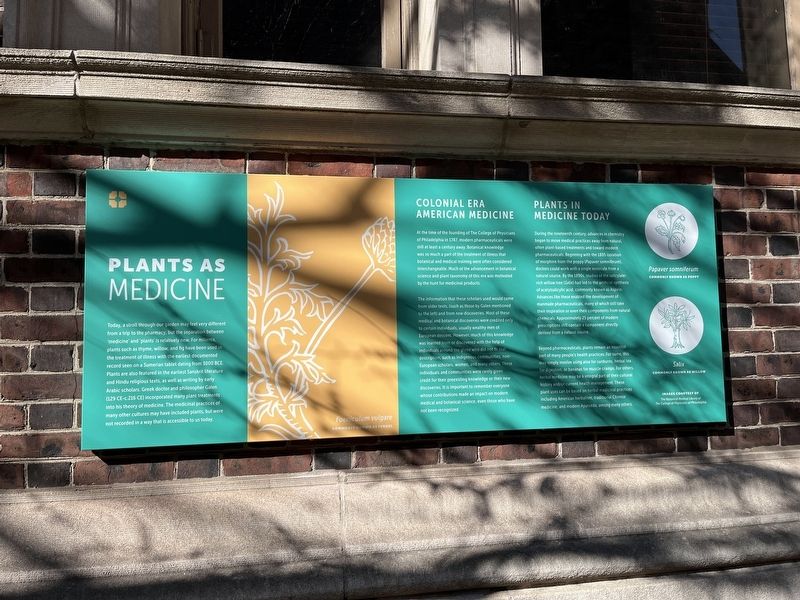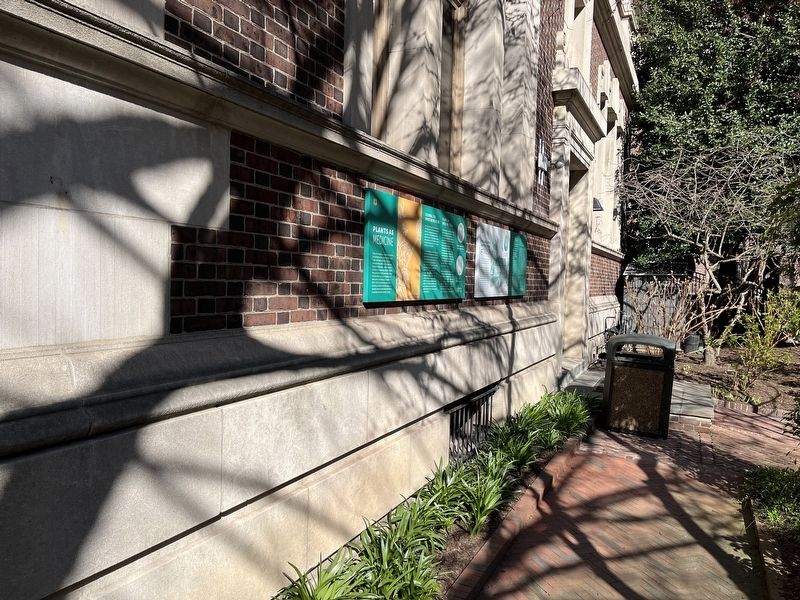Rittenhouse Square in Philadelphia in Philadelphia County, Pennsylvania — The American Northeast (Mid-Atlantic)
Plant As Medicine
Today, a stroll through our garden may feel different from a trip to the pharmacy, but the separation between 'medicine' and 'plants' is relatively new. For millenia, plants such as thyme, willow, and fig have been used in the treatment of illness with the earliest documented record seen on a Sumerian tablet dating from 3000 BCE. Plants are also featured in the earliest Sanskrit literature and Hindu religious texts, as well as writing by early Arabic scholars. Greek doctor and philosopher Galen (129 CE-c.216 CE) incorporated many plant treatments into his theory of medicine. The medicinal practices of many other cultures may have included plants, but were not recorded in a way that is accessible to us today.
Colonial Era American Medicine
At the time of the founding of The College of Physicians of Philadelphia in 1787, modern pharmaceuticals were still at least a century away. Botanical knowledge was so much a part of the treatment of illness that botanical and medicinal training were often considered interchangeable. Much of the advancement in botanical science and plant taxonomy of this era was motivated by the hunt for medicinal products.
The information that these scholars used would come from older texts, (such as those by Galen mentioned to the left) and from new discoveries. Most of these medical and botanical discoveries were credited only to certain individuals, usually wealthy men of European descent. However, much of this knowledge was learned from or discovered with the help of individuals around the globe who did not fit that description, such as indigenous communities, non-European scholars, women, and many others. These individuals and communities were rarely given credit for their preexisting knowledge or their new discoveries. It is important to remember that everyone whose contributions made an impact on modern medical and botanical science, even those who have been recognized.
Plants in Medicine Today
During the nineteenth century, advances in chemistry began to move medical practices away from natural, often plant-based treatments and toward modern pharmaceuticals. Beginning with the 1805 isolation of morphine from the poppy (Papaver somniferum), doctors could work with a single molecule from a natural source. By the 1890s, studies of the salicylate-rich willow tree (Salix) had led to the artificial synthesis of acetylsalicylic acid, commonly known as Aspirin. Advances like these enabled the development of manmade pharmaceuticals, many of which still take their inspiration or even their components from natural chemicals. Approximately 25 percent of modern prescriptions still contain a component directly
Beyond pharmaceuticals, plants remain an essential part of many people's health practices. For some, this may simply involve using aloe for sunburns, herbal tea for digestion, or bananas for muscle cramps. For others, herbal medicine may be an integral part of their cultural history and/or current health management. These plant uses can be based on herbal medicinal practices including American herbalism, traditional Chinese medicine, and modern Ayurveda, among many others.
Erected by The Mütter Museum.
Topics. This historical marker is listed in these topic lists: Anthropology & Archaeology • Colonial Era • Horticulture & Forestry • Science & Medicine.
Location. 39° 57.187′ N, 75° 10.598′ W. Marker is in Philadelphia, Pennsylvania, in Philadelphia County. It is in Rittenhouse Square. Marker is on South 22nd Street north of Ranstead Street, on the right. Touch for map. Marker is at or near this postal address: 19 S 22nd St, Philadelphia PA 19103, United States of America. Touch for directions.
Other nearby markers. At least 8 other markers are within walking distance of this marker. Benjamin Rush Medicinal Plant Garden (a few steps from this marker); Ginger (a few steps from this marker); a different marker also named Benjamin Rush Medicinal Plant Garden (a few steps from this marker); a different marker also named Benjamin Rush Medicinal Plant Garden (a few steps from this marker); The College of Physicians of Philadelphia Building (a few steps from this marker); First Unitarian Church of Philadelphia (within shouting distance of this marker); June 5th Memorial (about 300 feet away, measured in a direct line); First Troop Philadelphia City Cavalry (about 400 feet away). Touch for a list and map of all markers in Philadelphia.
Additional keywords. drugs, pharmacology, ecology, drug dealers
Credits. This page was last revised on February 2, 2023. It was originally submitted on April 6, 2022, by Devry Becker Jones of Washington, District of Columbia. This page has been viewed 70 times since then and 9 times this year. Photos: 1, 2. submitted on April 6, 2022, by Devry Becker Jones of Washington, District of Columbia.

